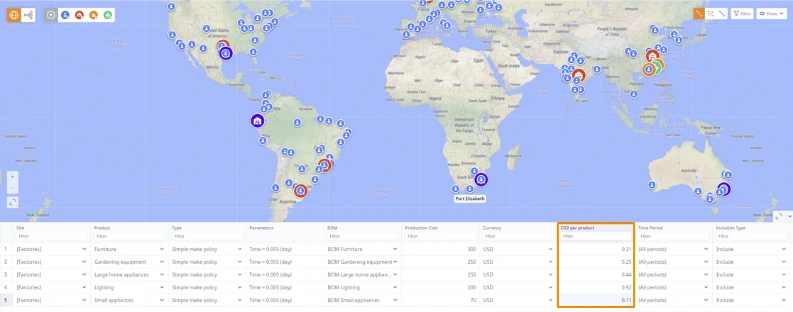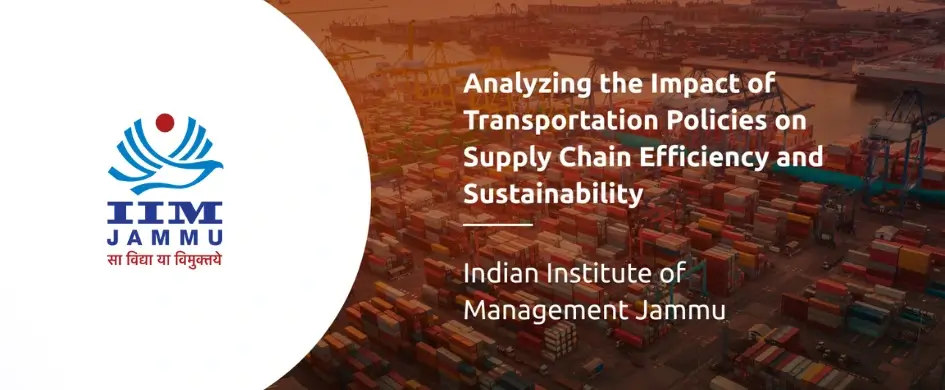This blog post is partially based on the presentation given at the anyLogistix Conference 2024 by Dr. Pratik Maheshwari from IIM Jammu.
Effective transportation planning and green supply chain management (GSCM) are critical for achieving operational efficiency and profitability. These practices address the growing demand for reliable delivery services while supporting environmental goals.
In this blog post, we explore the benefits of green supply chain management and transportation planning in supply chain management.
Contents:
- The importance of transportation planning
- The benefits of green supply chain management
- Innovative approaches for green supply chain management
- Transportation policies for an Indian sportswear manufacturer
- Conclusion
THE IMPORTANCE OF TRANSPORTATION PLANNING IN SUPPLY CHAIN MANAGEMENT
Transportation accounts for up to 60% of total logistics costs, making it the key to efficient supply chain management. The importance of transportation planning in supply chain management is difficult to underestimate. According to different studies quoted below, companies can improve and benefit from green supply chain management by adopting structured transportation planning. These improvements include:
- Reduced costs and enhanced profitability
Optimizing routes and vehicle utilization reduces fuel consumption and operational costs, contributing to overall supply chain profitability. Studies show a direct connection between transportation efficiency and profitability increase: a 10% improvement in transportation efficiency can yield a 5% increase in profitability.
- Improved customer satisfaction
Research highlights that more than 70% of online shoppers mentioned delivery speed as a key factor in purchasing decisions. Regarding loyalty, 93% of customers are likely to make repeat purchases with companies that offer excellent customer service. This is why efficient transportation is vital to ensure timely deliveries and meet customer expectations for speed and reliability.
- Strengthened supply chain resilience
A survey by the Business Continuity Institute found that 34.3% of organizations reported that delays in cross-border land transportation had a serious or catastrophic impact on their operations. Transportation planning enables companies to be better prepared for such disruptions on both global and local scales, ensuring continuity and reliability even in uncertain conditions.
- Enhanced operational visibility
GPS and the Internet of Things (IoT) increase supply chain transparency. New advanced technologies help to enhance real-time tracking and decision-making, reducing delays. Early adopters of AI reported a 15% reduction in logistics costs and a 65% enhancement in service levels.
THE BENEFITS OF GREEN SUPPLY CHAIN MANAGEMENT
More and more companies are introducing GSCM practices. However, what is green supply chain management, and what benefits can a company get from incorporating sustainability into its operations?
GSCM goes beyond traditional supply chain management by including environmental considerations in every stage of the supply chain, from raw material sourcing to final product delivery.
For example, efficient GSCM practices, such as adopting electric or hybrid vehicles and optimizing load capacities through transportation planning in supply chain management, can reduce carbon emissions by up to 30%.
With rising environmental awareness, companies must meet specific regulations, so GSCM is becoming a critical strategy. Adopting GSCM enhances a company’s reputation and brand image. Moreover, when done right, it can bring a competitive advantage with millions saved thanks to resource optimization and improved resilience.
Curious how companies benefit from incorporating sustainability into their supply chains? Check out case studies of an Italian dairy company and a Canadian company Valorix. There, you will learn how leading businesses use anyLogistix to not only reduce their carbon footprint but also minimize supply chain costs.
INNOVATIVE APPROACHES FOR GREEN SUPPLY CHAIN MANAGEMENT
Innovative technologies and policies are shaping the future of transportation planning in supply chain management. For example, digital twins enable companies to create virtual replicas of their supply chains, allowing for better monitoring, prediction, and optimization of operations that bring benefits of green supply chain management. Meanwhile, easier ways for CO2 emission calculation help businesses accurately track their carbon footprint and identify opportunities to reduce it.
By offering robust capabilities, anyLogistix also addresses key challenges and unlocks new opportunities for efficiency and sustainability:
Digital twins
Detailed simulation models of actual supply chains use real-time data and snapshots to forecast supply chain dynamics. Such virtual replicas of supply chains enable scenario analysis and predictive modeling, improving decision-making and sustainability. They allow test transportation strategies in a controlled, risk-free environment before applying them to the physical network.
CO2 emission calculation and optimization
If your green strategy prioritizes reducing CO2 emissions, it is essential to set an objective to minimize them. anyLogistix includes built-in cost parameters for CO2 emissions, enabling the model to calculate them effectively and optimize solutions based on this objective.
anyLogistix enables precise calculation of CO2 emissions from facility operations, including production processes and inventory storage. It also allows you to assess the environmental impact of opening or closing facilities along the supply chain, providing insights into potential emissions.
An example of green supply chain management in anyLogistix (click to enlarge)
Transportation activities, often the most significant contributor to pollution, can also be analyzed within anyLogistix. The software allows the consideration of vehicle type, delivery distance, and product weight, making calculations precise and realistic.
To get a comprehensive view, the total CO2 metric consolidates emissions across all categories—facilities, processing, and transportation—offering a clear understanding of the overall carbon footprint.
Looking for ways to reduce your supply chain's carbon footprint? Check out our step-by-step guide on achieving CO2 emission reductions with anyLogistix.
Advanced dashboards for analytics
anyLogistix 3.3 redefines data presentation with the graphical statistics display feature. Users can now create intuitive charts, bar graphs, or histograms to represent critical metrics like transportation efficiency, emissions by vehicle type, or facility operations. By displaying these statistics side by side, you can quickly identify trends and make decisions aligned with sustainability goals.
Another helpful feature for green supply chain management is a flexible KPI metrics panel, which displays performance indicators that stay visible across all dashboard views. Comparing KPIs from multiple experimental runs simplifies performance benchmarking for greener supply chain strategies. For example, you can compare CO2 metrics from different scenarios.
KPI metrics panel in anyLogistix to compare CO2 metrics from different scenarios runs (click to enlarge)
With the release of anyLogistix 3.3, the dashboard look took a big step forward, making tracking and analyzing necessary KPIs easier. Want to know more? Read our blog post about anyLogistix 3.3 and its benefits to every user.
TRANSPORTATION POLICIES FOR AN INDIAN SPORTSWEAR MANUFACTURER
The case study, presented at the anyLogistix Conference 2024, focused on integrating sustainability into the supply chain, particularly in India’s growing sportswear market, and highlighted the role of transportation planning and CO2 emission reduction strategies.
The study included data from over 100 cities and emphasized the need to incorporate emission rates into transportation policies. The researchers used real-world data on CO2 emissions from road and rail transport in India, analyzing these emissions through a hybrid methodology. It combined case study analysis and discrete event simulation. The study specifically evaluated full truckload and half truckload calculations to minimize CO2 emissions and transportation costs.
The simulation model integrated various factors like inventory and transportation costs, and emission rates across different Indian states.
Watch this insightful presentation about transportation planning in supply chain management from the anyLogistix Conference 2024, given by Dr. Pratik Maheshwari from IIM Jammu.
GREENER SUPPLY CHAIN—BETTER RESULTS
By integrating eco-friendly practices and leveraging advanced tools like anyLogistix, businesses can achieve remarkable results: reduced costs, lower carbon footprints, and enhanced customer satisfaction. A greener supply chain fosters better operational outcomes and ensures long-term resilience and a positive brand reputation.
The journey toward sustainability is a strategic investment in a brighter, more sustainable future, and it is easy to start this journey with anyLogistix.
Download anyLogistix for free and start building a greener supply chain today.
download




